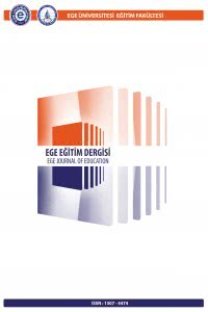Öğrenme Eksiklerinin Belirlenmesinde Klasik Test Teorisine Dayalı Yöntemler ve DINA Modelin Karşılaştırılması
Bu araştırmada öğrenme eksikliklerinin belirlenmesi amacıyla kullanılan iki yöntemin sonuçlarının uyumu incelenmiştir DINA model Deterministic Inputs Noisy And Gate Bilişsel Tanı Modelleri arasında yer alan ve özellikle öğrenme eksiklerini belirlemek amacıyla geliştirilen çok boyutlu bir örtük sınıf analizidir DINA model öğrenme eksiklerini belirlerken geleneksel yöntemdeki gibi öğrencilere ilişkin test toplam puanlarını kullanmamaktadır Bunun yerine modelle üretilen madde parametreleri aracılığıyla öğrencilerin belirlenen özelliklere sahip olup olmadıkları yönünde kategorik kararlar vermektedir Araştırmada öğrenme eksikliklerinin belirlenmesi konusunda iki yöntemin hem konuların öğrenilme düzeyi hem de öğrencilerin bireysel olarak öğrenme eksiklikleri incelenmiştir Bu bakımdan araştırmada öğretim ve öğrenme eksikliklerinin belirlenmesi konusunda iki yöntemin verdikleri kararların bezerlikleri ve farklılıklarının ortaya koyulması amaçlanmıştır
Anahtar Kelimeler:
-
The Comparison of DINA Model and Classical Test Theory in Determining the Learning Gaps
-
___
- Brown, W.K., Cozby, C. P., Kee, D.W. ve Worden, P.E. (1999). Research methods in human development, (2nd ed.). USA: Mayfield Publishing Company
- Cheng, Y. (2010). Improving cognitive diagnostic computerized adaptive testing by balancing attribute coverage: The modified maximum global discrimination ındex method. Educational and Psychological Measurement, 70 (6), 902-913.
- de la Torre, J. (2008). An empirically-based method of Q-matrix validation for the DINA model: Development and applications. Journal of educational measurement, 45, 343–362.
- de la Torre, J. (2009a). DINA model and parameter estimation: A didactic. Journal of educational and behavioral statistics, 1 (34), 115–130.
- de la Torre, J. (2009b). DINA model and parameter estimation: A didactic. Journal of educational and behavioral statistics, 1 (34), 115–130.
- de la Torre, J. ve Douglas, J. (2008). Model evaluation and multiple strategies in cognitive diagnosis: An analysis of fraction subtraction data. Psychometrika, 3 (73), 595-624.
- de la Torre, J. ve Liu, Y. (2008). A cognitive diagnosis model for continuous response. National council on measurement in education New York, Mart’ta sözlü bildiri olarak sunulmuştur.
- Meeting of the National Council on Measurement in Education, Chicago, IL, 24 Nisan’da sözlü bildiri olarak sunulmuştur.
- Doignon, J. P. ve Falmagne, J. C. (1999). Knowledge spaces. New York, NY: Springer-Verlag
- Embretson, S. (1984). A general latent trait model for response processes. Psychometrika, 49, 175-186.
- Haertel, E.H. (1989). Using restricted latent class models to map the skill structure of achievement items. Journal of Educational Measurement, 26, 333-352.
- Huebner, A., Wang, B. ve Lee, S. (2009). Practical issues concerning the application of the DINA model to CAT data, D. J. Weiss (Ed.), Proceedings of the 2009 GMAC Conference on Computerized Adaptive Testing.
- Karasar, N. (1998). Araştırmalarda rapor hazırlama yöntemi. Ankara: Pars Matbaacılık Sanayi.
- Leighton, J. P. ve Gierl, M. J. (2007). Why cognitive diagnostic assessment? J. P. Leighton ve M. J. Gierl, (Ed.). Cognitive Diagnostic Assessment for Education. New York: Cambridge University Press.
- Levin, J., Fox, J.A., (1991). Elementary Statistics. New York: Harper Collins Publishers Inc.
- Macready, G.B., Dayton, C.M. (1977). The use of probabilistic models in the assessment of mastery. Journal of Educational Statistics, 2, 99–120.
- Mcglohen, M.K. (2004). The application of a cognitive diagnosis model via an analysis of a large-scale assessment and a computerized adaptive testing administration. Yayınlanmamış doktora tezi, The University of Texas Austin.
- Montero, D., Molfils, L., Wang, J., Yen, W., Julian, M. ve Moody, M. (2003). Investigation of the application of cognitive diagnostic testing to an end- of-course- high school examination, Annual Meeting of the National Council on Measurement in Education, Chicago, IL, 24 Nisan’da sözlü bildiri olarak sunulmuştur.
- Murphy, K. R. ve Davidshofer, C. O. (2001). Psychological testing. (5th ed.). New Jersey: Prentice-Hall, Inc.
- Tatsuoka M. M. ve Tatsuoka, K. K. (1989). Rule space. Encyclopedia of statistical sciences içinde (217-220). New York: Wiley.
- Tatsuoka, K. (1985). A probabilistic model for diagnosing misconceptions in the pattern classification approach. Journal of Educational Statistics, 12, 55–73.
- Tatsuoka, K. (1995a). Architecture of knowledge structures and cognitive diagnosis: A statistical pattern recognition and classification approach. P.D. Nichols, S. F Chipman, R. L. Brennan ( ed.), Congnitively diagnostic assessment, Routledge, New York: Taylor & Francis Group.
- Tatsuoka, K. (1995b). Cognitive assessment an introduction to the rule space method, Routledge, New York: Taylor & Francis Group.
- Wenmin, Z. (2006). Detecting differential item functioning using the DINA model. Yayınlanmamış doktora tezi, The University of North Carolina at Greensboro.
- ISSN: 1307-4474
- Yayın Aralığı: Yılda 3 Sayı
- Başlangıç: 2001
- Yayıncı: Ege Üniversitesi Eğitim Fakültesi
